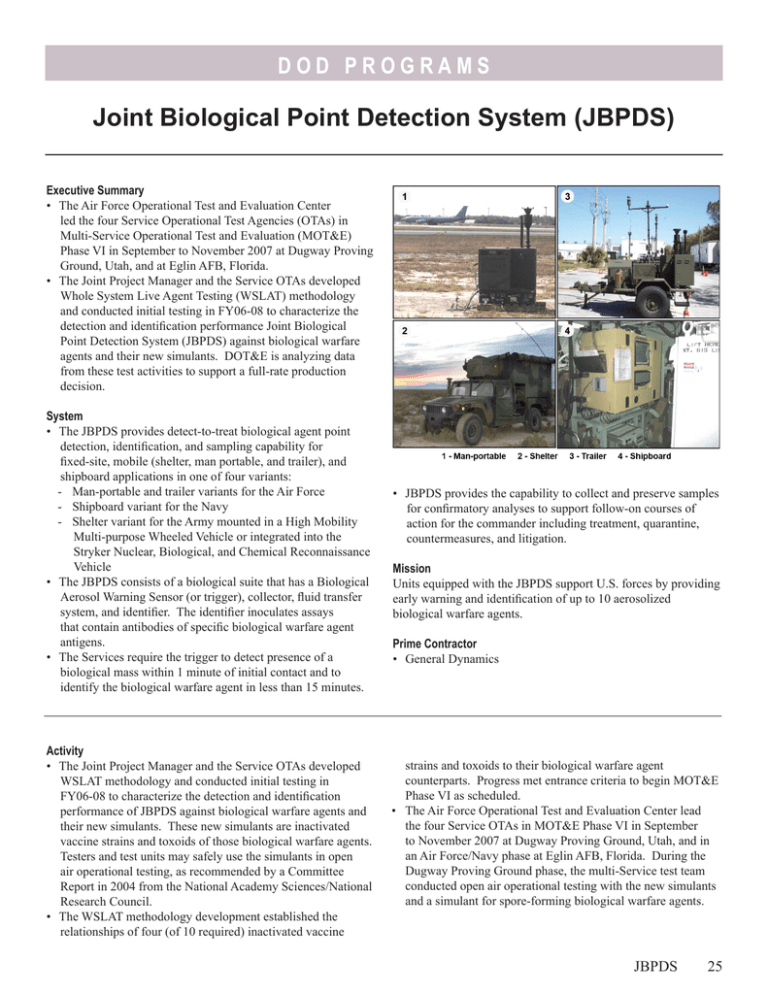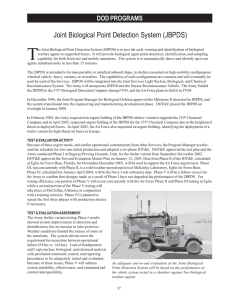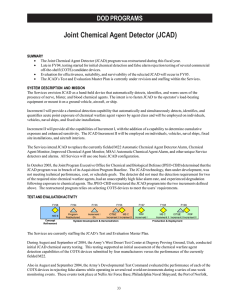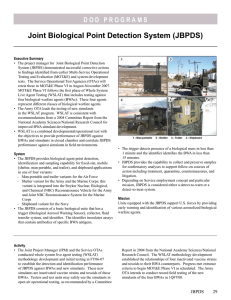Joint Biological Point Detection System (JBPDS)
advertisement

DOD P RO G R A M S Joint Biological Point Detection System (JBPDS) Executive Summary • The Air Force Operational Test and Evaluation Center led the four Service Operational Test Agencies (OTAs) in Multi‑Service Operational Test and Evaluation (MOT&E) Phase VI in September to November 2007 at Dugway Proving Ground, Utah, and at Eglin AFB, Florida. • The Joint Project Manager and the Service OTAs developed Whole System Live Agent Testing (WSLAT) methodology and conducted initial testing in FY06-08 to characterize the detection and identification performance Joint Biological Point Detection System (JBPDS) against biological warfare agents and their new simulants. DOT&E is analyzing data from these test activities to support a full-rate production decision. System • The JBPDS provides detect-to-treat biological agent point detection, identification, and sampling capability for fixed‑site, mobile (shelter, man portable, and trailer), and shipboard applications in one of four variants: - Man-portable and trailer variants for the Air Force - Shipboard variant for the Navy - Shelter variant for the Army mounted in a High Mobility Multi-purpose Wheeled Vehicle or integrated into the Stryker Nuclear, Biological, and Chemical Reconnaissance Vehicle • The JBPDS consists of a biological suite that has a Biological Aerosol Warning Sensor (or trigger), collector, fluid transfer system, and identifier. The identifier inoculates assays that contain antibodies of specific biological warfare agent antigens. • The Services require the trigger to detect presence of a biological mass within 1 minute of initial contact and to identify the biological warfare agent in less than 15 minutes. Activity • The Joint Project Manager and the Service OTAs developed WSLAT methodology and conducted initial testing in FY06-08 to characterize the detection and identification performance of JBPDS against biological warfare agents and their new simulants. These new simulants are inactivated vaccine strains and toxoids of those biological warfare agents. Testers and test units may safely use the simulants in open air operational testing, as recommended by a Committee Report in 2004 from the National Academy Sciences/National Research Council. • The WSLAT methodology development established the relationships of four (of 10 required) inactivated vaccine • JBPDS provides the capability to collect and preserve samples for confirmatory analyses to support follow-on courses of action for the commander including treatment, quarantine, countermeasures, and litigation. Mission Units equipped with the JBPDS support U.S. forces by providing early warning and identification of up to 10 aerosolized biological warfare agents. Prime Contractor • General Dynamics strains and toxoids to their biological warfare agent counterparts. Progress met entrance criteria to begin MOT&E Phase VI as scheduled. • The Air Force Operational Test and Evaluation Center lead the four Service OTAs in MOT&E Phase VI in September to November 2007 at Dugway Proving Ground, Utah, and in an Air Force/Navy phase at Eglin AFB, Florida. During the Dugway Proving Ground phase, the multi-Service test team conducted open air operational testing with the new simulants and a simulant for spore-forming biological warfare agents. JBPDS 25 DOD P RO G R A M S • The Joint Requirements Oversight Council approved the Capability Production Document for the JBPDS Increment 1 on October 15, 2008. • The Joint Program Executive Office for Chemical Biological Defense plans to make a full-rate production decision and an ensuing competitive procurement to be awarded in spring 2009. The Army OTA will continue WSLAT for six additional biological warfare agents that JBPDS is required to detect and identify after the full-rate production decision. Assessment • Analysis and evaluation of the MOT&E and WSLAT results are ongoing. • WSLAT is important because it demonstrates end-to-end performance against live biological warfare agents, provides concentration levels of lower limits of detection and identification, and establishes relationships between biological warfare agents and their simulants. 26 JBPDS Recommendations • Status of Previous Recommendations. The Joint Program Manager and Service OTAs implemented prior DOT&E recommendations. • FY08 Recommendations. 1. The Joint Program Manager and Army Test and Evaluation Command must continue to characterize the detection and identification performance of JBPDS against the remaining 10 biological warfare agents and their simulants in WSLAT and field tests. 2. Regardless which vendor successfully competes for the full-rate production, the Operational Test Agencies must confirm operational effectiveness and suitability with an operational test.








